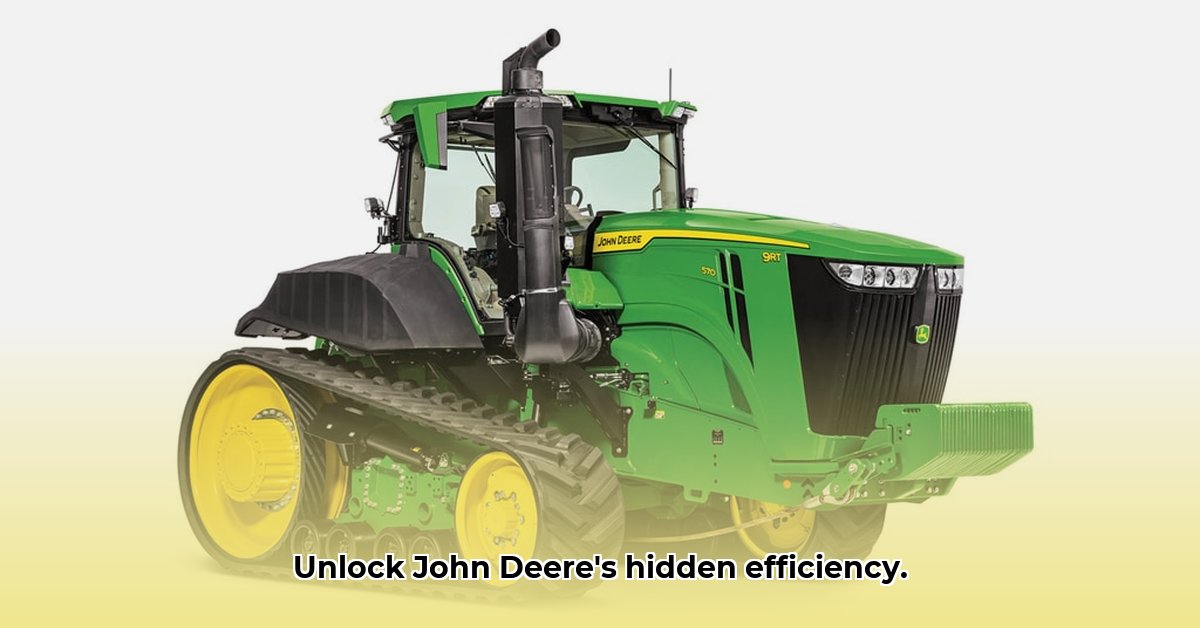
John Deere 9RX Tracked Tractor: A Deep Dive into Sustainable Productivity
The John Deere 9RX tracked tractor represents a significant advancement in agricultural technology, promising increased efficiency and reduced environmental impact. This in-depth analysis examines its capabilities, cost considerations, and implications for sustainable farming practices. Is the 9RX's high initial investment justified by its long-term benefits? Let's explore the data. For more details, see the 9RX Tractor Specs.
Power and Productivity: Maximizing Output
The 9RX series boasts impressive horsepower, enabling the use of wider implements and significantly increased field coverage. How much faster is it, really? Reports suggest a potential doubling of output in challenging conditions and speed increases of up to a mile per hour in easier terrain 1. This translates to a substantial increase in acreage covered per day, a critical advantage for large-scale operations. Additionally, enhanced operator comfort contributes to longer, more productive workdays, maximizing the tractor's full potential. But does this translate to a worthwhile return on investment?
Fuel Efficiency: Lower Costs, Lower Emissions
Fuel costs represent a substantial expense for agricultural operations. The 9RX’s innovative engine design (requiring no diesel exhaust fluid) contributes to noticeably lower fuel consumption compared with many comparable machines, which leads to significant cost savings and a reduced environmental footprint. The available Fast Fill system further enhances operational efficiency by minimizing fuel-stop downtime. However, is the proprietary fuel system a barrier to entry or a long-term benefit? This requires careful analysis.
Soil Conservation: Protecting Your Most Valuable Asset
Sustainable farming practices prioritize soil health. Heavy machinery can compact soil, hindering yields and long-term land productivity. The 9RX's advanced undercarriage and weight distribution minimize soil compaction, even on uneven terrain. Using wider implements reduces the number of passes across fields, further mitigating compaction. This addresses a critical challenge within sustainable agriculture, showing a clear commitment to land stewardship. But how does the 9RX's soil compaction performance compare across different soil types? Further research is needed to clarify this.
Technological Integration: Data-Driven Decision Making
Modern farming relies heavily on data-driven decision making. The 9RX seamlessly integrates with John Deere's precision agriculture technology, providing real-time data on fuel consumption, yield, and other key metrics. This empowers farmers to make informed decisions, optimize resource allocation, and enhance overall operational efficiency. However, compatibility with third-party farm management systems is crucial for maximizing data utility. Poor data integration would negate many of the benefits of this advanced technology.
Sustainable Farming: A Holistic Perspective
Sustainability in agriculture extends beyond immediate operational efficiency. The 9RX’s overall environmental impact needs comprehensive consideration. This includes analyzing the machine's entire life cycle—from manufacturing to disposal—to assess its total carbon footprint. Ongoing research is exploring ways to further minimize the 9RX's greenhouse gas emissions. This holistic approach is vital, ensuring long-term sustainability. How can we further reduce the machine's carbon footprint throughout its life cycle? This requires continued research and innovation.
The Investment Decision: A Comprehensive ROI Analysis
The 9RX's high initial cost necessitates a robust return on investment (ROI) analysis. This should consider:
- Initial Investment: This encompasses the purchase price, attachments, and setup costs. Precise budgeting is essential.
- Operational Costs: Include fuel consumption, maintenance, repairs, labor, and insurance. Accurate projections across different soil types are crucial.
- Revenue Projections: Estimate increased productivity (hectares per day, yield increases) and potential improvements in crop quality. Consider market prices for your crops.
- Resale Value: Factor in projected depreciation and resale value after your intended usage.
- ROI Calculation: Use the standard ROI formula:
(Total Revenue Increase - Total Costs) / Total Investment Cost * 100%. Consult with financial experts for a more thorough analysis.
Key Considerations Beyond the Numbers
While a thorough ROI analysis is crucial, several qualitative factors also impact the decision:
- Farm Size and Crop Types: The 9RX's suitability depends on your specific farming operation.
- Technological Proficiency: Ease of use and available training are key considerations.
- Financing Options: Explore various financing mechanisms to manage the high initial cost.